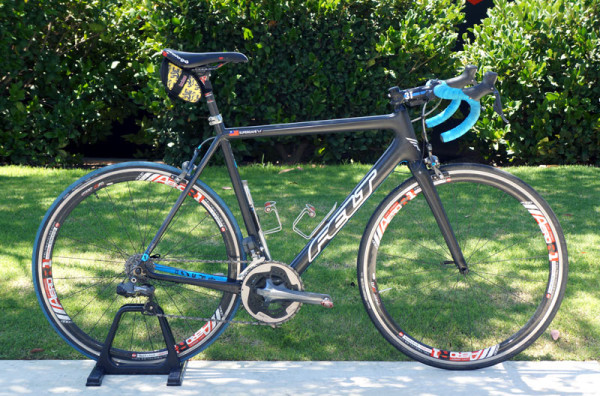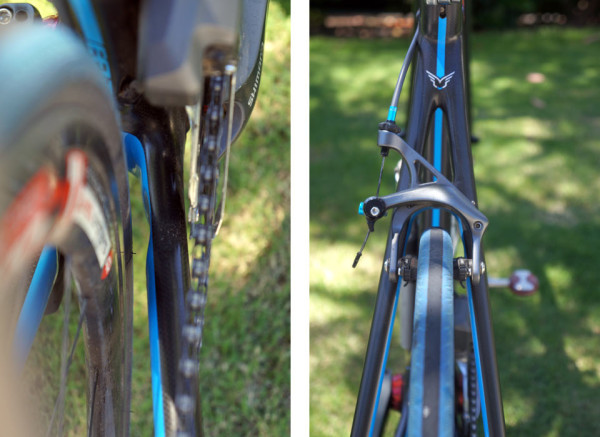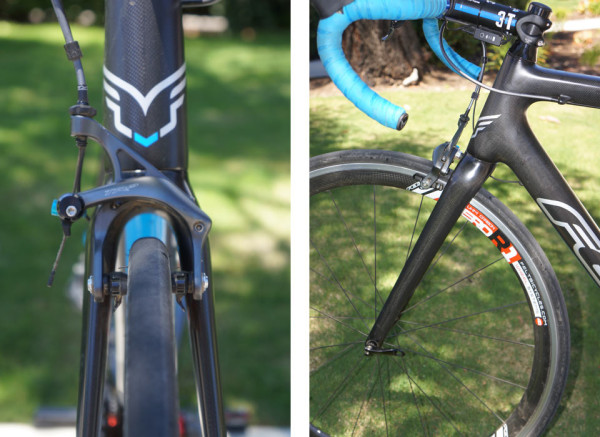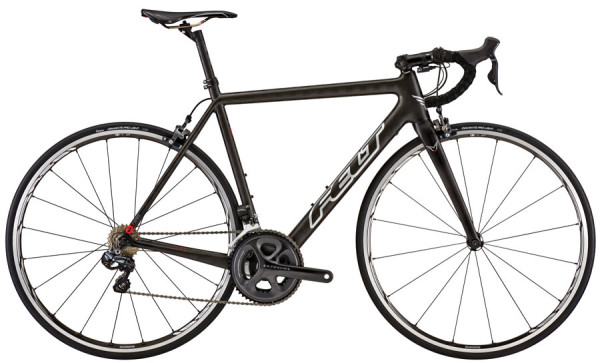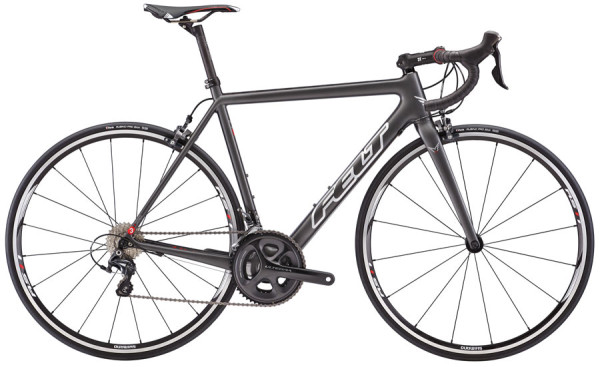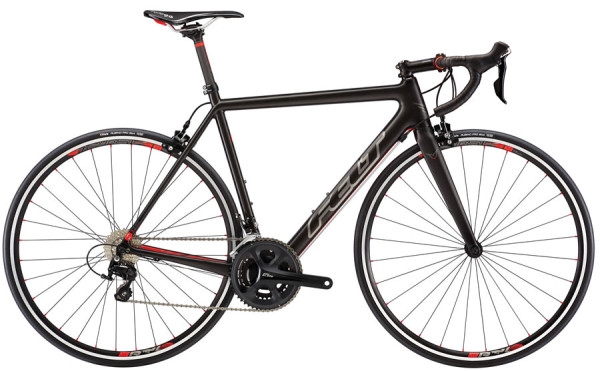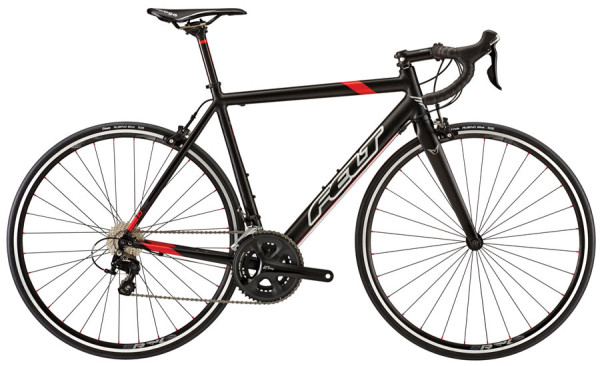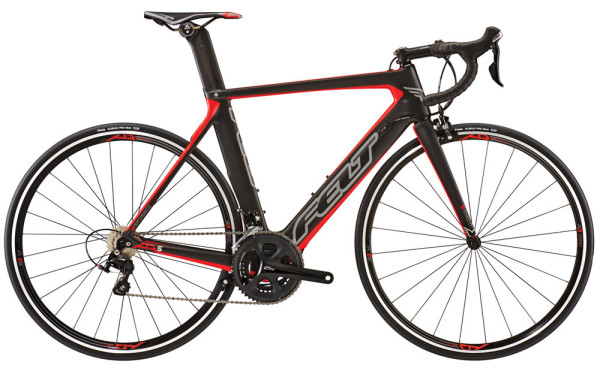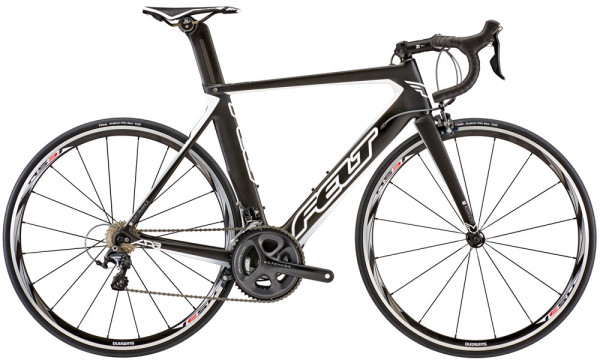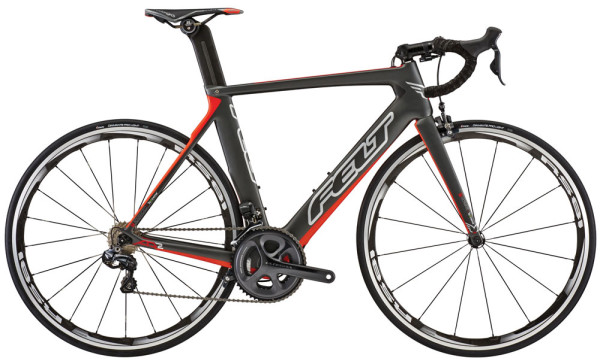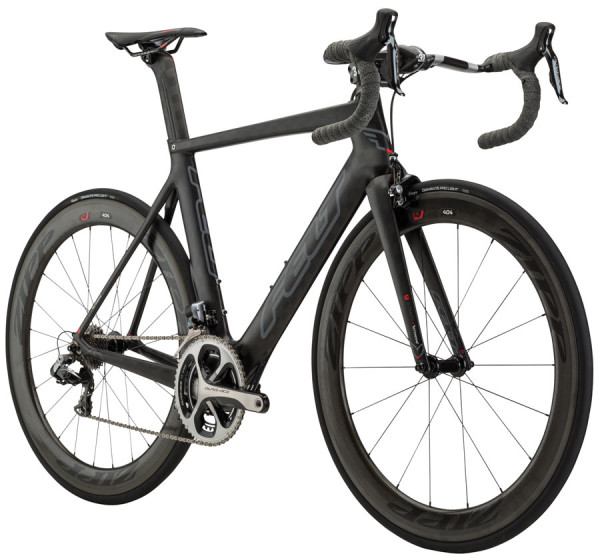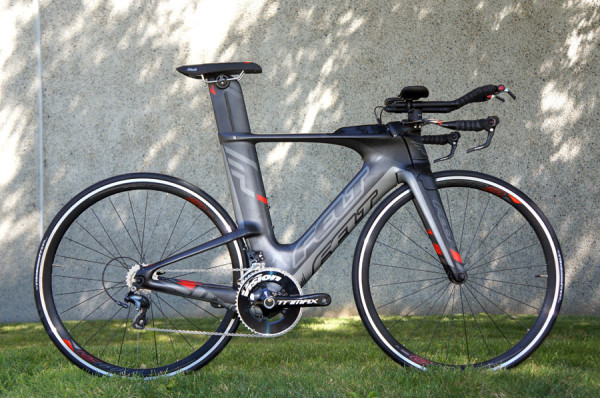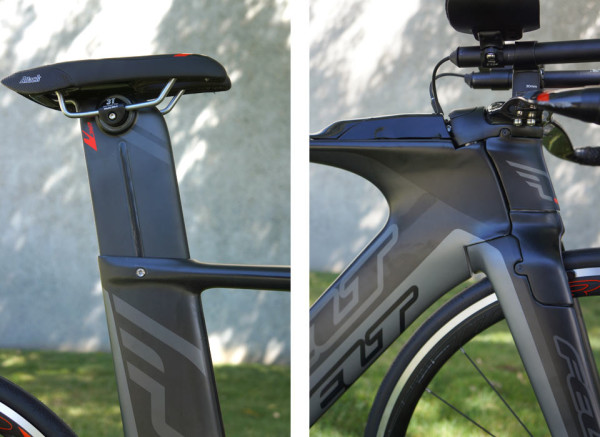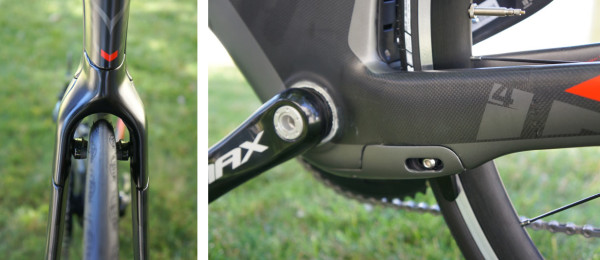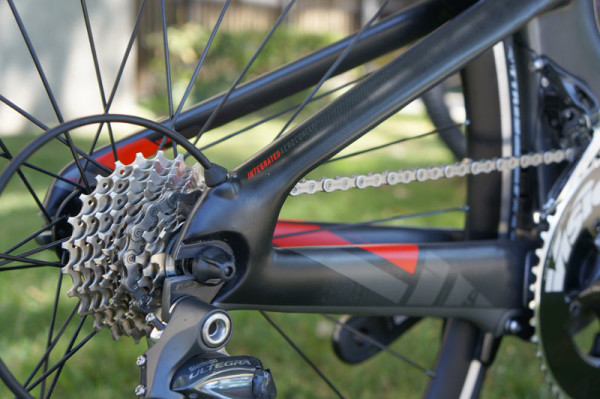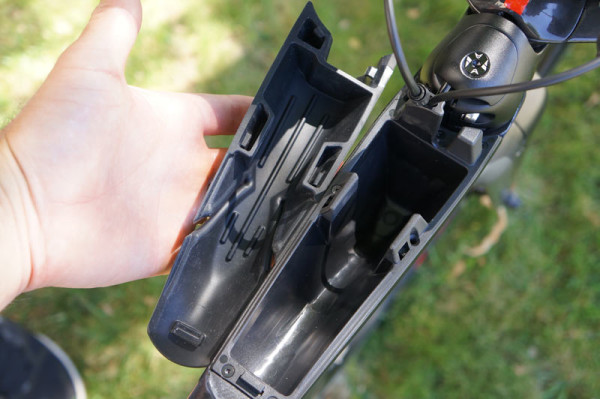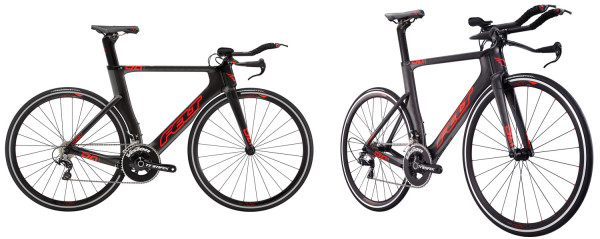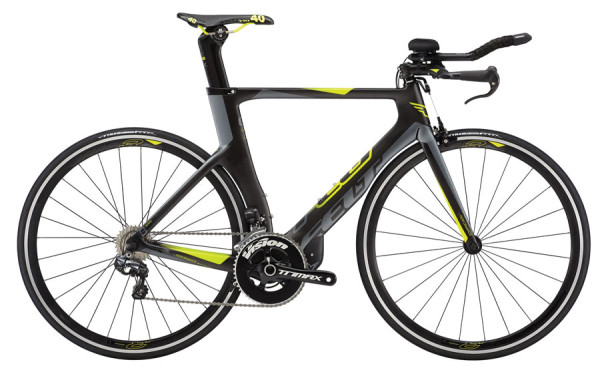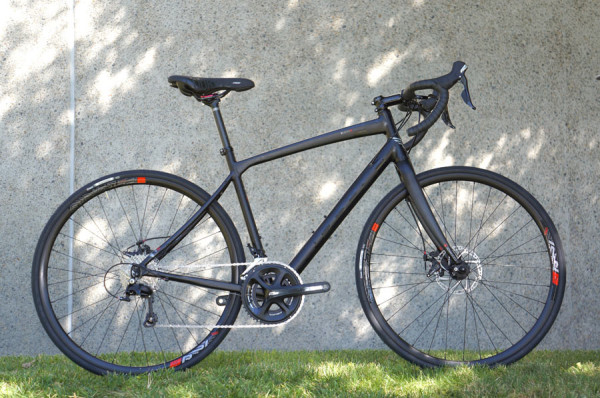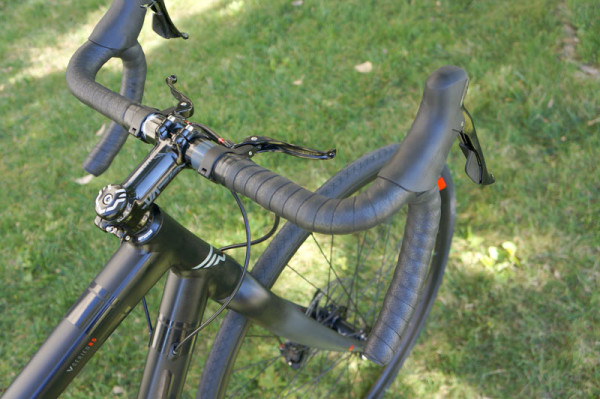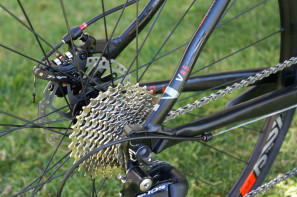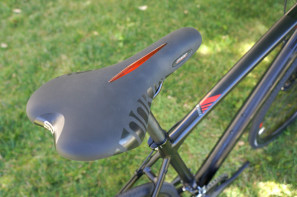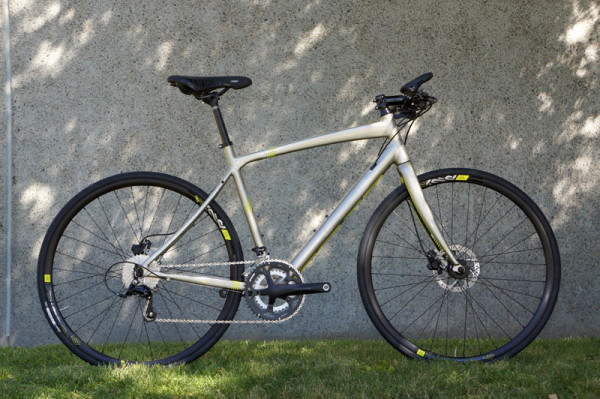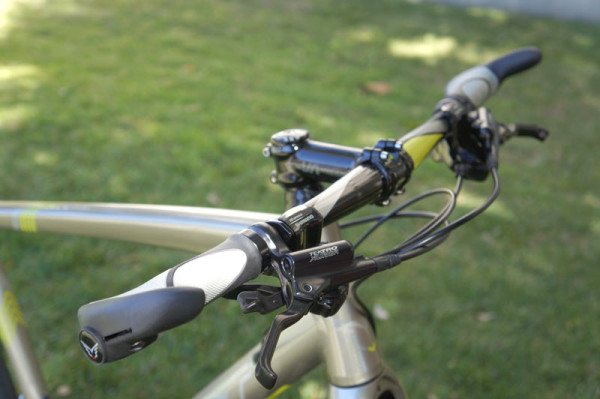So far, we’ve seen Felt’s 2015 mountain bikes, cyclocross bikes and their new-to-the-USA e-bike line. Now, we’ve got the first installment of 2015 road bikes. We say first installment because, well, there’s more coming, we just can’t talk about them until Eurobike.
Across the range, Felt’s 2015 road bikes see a lot of trickle down tech to bring their AR (Aero Road), F (Racing) and triathlon designs to lower price points through the use of lower level carbon and smarter spec. They’ve also added a new V-series that splits the difference between road and commuter, plus a limited edition bike for the cobbles.
Above is the new Felt F1 PR, so dubbed for the Paris Roubaix races it was used for under the Argos-Shimano riders last year. Felt custom tweaked a few F1 road bikes for the rougher spring classics by raising the rear axle a bit and extending the chainstays. That, plus a little extra clearance at the seat stays, allowed for larger diameter tires while keeping the bottom bracket at the correct height.
It worked well, but as UCI rules dictate, team members had to be riding something in or destined for production, so Felt made a limited run. Except they couldn’t call it the Paris Roubaix, so it just became the F1 PR…
This complete bike shown here is a team mockup or training bike, not the production spec. Interestingly, The F1 PR’s frame sits somewhere between the top level F FRD frameset and F2/3, which get their top level carbon and TeXtreme, and the F5, which has their base level carbon. The F1 PR gets a top level Ultimate + Nano carbon fiber.
It has plenty of room for big rubber. It comes spec’d with Challenge Paris Roubaix Open Tubular 700x27c tires, but they say you can fit 32c cyclocross tires in there.
The fork is a new part, too, offering a bit more height and steadier handling. TRP RG957 long reach brake calipers are spec’d front and rear.
Here’s what the production model looks like, decked out with Mavic Ksyrium Elite wheels, Ultegra cranks and shifters with Dura-Ace derailleurs and a mostly Felt cockpit with 3T Ionic seatpost. Retail is $4,999 complete and $2.499 for the frame kit.
2015 FELT F-SERIES
The F-Series is Felt’s race series, focusing on high stiffness to weight ratios. They have steep angles, agile handling and low head tubes. The top level FRD is a sub 1000g frameset. Yes, frame and fork together are under 1kg. And it’s been that way since 2010. Frame is around 700g for a 56, and uncut fork is around 250g. Those frames are electronic only, and that’s done because it’s a top end bike and top end groups are now electronic (or soon will be), and because putting more holes in a frame for cables requires more reinforcement, which adds weight.
For 2015, the mold is the same but brings in lower level models to hit lower prices. It also brings in lower lever Textreme bikes to deliver the top level frame in more affordable builds. There’s also an F1 TeXtreme frameset that replaces their FC offering. It’s the lightest and combines their UHC Ultimate carbon with TeXtreme. The F1 frameset combines their UHC Advanced carbon with TeXtreme, as does the F2 (above) and F3 (below) both upgrade to TeXtreme enhanced frames for claimed weights of 15.5lb (7.08kg) and 17.0lb (7.73kg) respectively. The F2 gets spec’d with Ultegra Di2 and Shimano RS81 tubeless road wheels, Prologo Nago Evo saddle and Felt/3T cockpit for $4,999.
The F3 gets a mechanical Ultegra build with RS11 wheels and slightly lesser cockpit for $2,999.
The F5 loses the TeXtreme to come in at $1,999 with a 105 group, Felt’s new wider alloy tubeless ready road wheels and house brand carbon seatpost.
Side note: Felt’s upper end FRD frames are designed specifically for electronic systems, made to fit just a single drivetrain wire. However, some of their new cyclocross bikes use those same ports to run a rear-only shift cable (like CX1) for a very clean look, so if you wanted to run a 1x road bike, you could convert some of their road bikes to it with an internal rear shift cable. The lower level bikes use a mechanical frame mold that’s designed with standard drivetrains in mind, but aftermarket port plugs are available to hold wires.
Another side note: Felt provided pictures of an F4, F6 and F7, but they’re not listed in the dealer catalog so we’ve held off on publishing them until we confirm they’re going to be available.
Below the carbon is the new F75, an alloy crit racer’s dream, offering the same geometry in a ready-to-race package for just $1,399. Spec includes a near complete 105 group, save for lower level Shimano brakes. Felt’s tubeless ready alloy wheels, carbon post and alloy stem and bar round things out.
2015 FELT AR-SERIES
Felt’s AR (Aero Road) line debuted at the 2012 Tour de France and was redesigned for MY2014.
For 2015, the AR5 brings the aerodynamics and seatpost tech down a price point and introduces a few improvements to rider comfort. The frame molds are the same, with the same UHC Performance carbon as the model above it, so it’s really only spec that gets downgraded. It even maintains the unique aero seatpost that uses an internal clamp to pull the post against the frame rather then clamp the frame against the post. This gave Felt a tremendous amount of freedom in the post’s design, letting them make the walls thinner for better compliance and use a much deeper profile. They have 25mm offset, but the post’s shape is symmetrical, so it can be installed backward to put the saddle further forward. Just clamp some aero bars on and you’ve got a makeshift TT/Tri bike. The large offset of the post means it goes between an effective 73º to 78º seat tube angle. For 2015, they’ve added a 5mm offset version, too.
Retail for the AR5 is $2,599 with Shimano 105 11-speed and Felt’s own shallow aero alloy wheels.
The AR3 was updated to work with mechanical groups, not just electronic ones, and the seatpost is now co-branded with 3T and adds the Italian brand’s vibration absorbing elastomer round the saddle clamps. It adds about 25g over the FRD’s post without it, and all frames except the FRD will get the 3T edition of the post. It’s a side clamp design, but will work with any size rails except Monolink. Retail is 3,499 for a complete bike with Ultegra mechanical. Claimed weight is 18.1lb (8.27kg).
The AR2, above, and FRD, below both get TeXtreme carbon frames. Both are designed for electronic groups only, but like the F-Series, can use the ports to run a mechanical 1×11 group, too. The AR2 has a claimed weight of just 16.4lb (7.49kg) with Shimano Ultegra Di2, Shimano RS81 wheels and 3T stem and carbon aero handlebar. Retail is $6,299.
The AR FRD comes in at $12,999 with full Dura-Ace Di2, Zipp 404 Firecrest wheels, an FSA bottom bracket with ceramic bearings and 3T cockpit.
2015 FELT TRIATHLON
The IA (Integrated Aero) triathlon bike was introduced last year, but has been slowly but surely getting into actual production. The top level FRD remains, but now there’s a lower level IA4 UHC Advanced carbon frame (shown) with Ultegra mechanical group. It comes in at $5,499. Compare that to the $6,999 FRD frameset, and you get a complete, race-ready bike whose frame is just as aero. Like most mid-level tri bikes, it comes with fairly shallow alloy wheels, letting you put the hoops of your choice on there for race day.
An IA3 does bump up to deep carbon Novatec wheels with SRAM Red. The IA2 gets Dura-Ace Di2 with deeper TTR0 Novatec wheels like the FRD, and you’ll be able to get an IA1 frameset for $4,499.
The high lift air foil sections on the bike have an overall negative drag and use very non-UCI cross sections up to 8:1. Like the AR, every tube section’s shape was picked for that particular part of the bike, and it allows them to keep it from stalling at up to 30º yaw angle, which is massive. That leads to less drag, but also more stability. The tube shapes also mean a more subtle transition from propulsion to drag, so there won’t be a noticeable buffet when it crosses that line.
At the top level, the UCI-legal DA1 gets the Textreme treatment and a new front end fairing to hide an internally mounted front brake.
The B-series gets a new B2 model with Ultegra Di2 at just $3,699 for a complete carbon fiber-framed bike.
That line drops all the way down to the B12 (left, $2,999) with a Dura-Ace derailleur/MicroShift/FSA Vision crankset mix and the B14 (right, $1,999) with an Ultegra derailleurs/MicroShift/FSA cranks. All B-series carbon frames are the same across the line with hidden direct mount rear brake under the BB, and they all get the same aero handlebar and extensions with Felt’s own aero brake calipers.
All three B-series bikes are available in a 47cm frame size with 650C wheels. For 2015, almost all DA, IA and B-series triathlon bikes and framesets get the 3T elastomer clamp holding an Adamo Attack saddle.
2015 FELT CITY & COMMUTER
To bridge the gap between a commuter/city bike, there’s an all-new alloy V-series line with geometry somewhere between an upright commuter and endurance road bike. It’ll handle up to 38c tires (spec’d with 28c or 30c, though), only uses disc brakes, wide range cassettes and mostly compact cranksets. Modern touches like internal cable routing round it out.
Models vary from getting tall stems with drop bars and secondary brake levers on the flats, to negative rise stems with drop bars to models with flat bars. They ship with two upper headset bearing covers, letting you get a 25mm stack bonus while still looking clean or helping you slam that stem.
The V85 (shown) with Shimano 105 11-speed and blacked out color scheme is $1,399. The V100 comes in at $849 with an 8-speed Shimano Claris drivetrain. All of the V-series bikes get high end Selle Royale Look In Athletic saddles.
The flat bar V90 (shown) is more about speedy commuting or fitness riders and get ergonomic grips with integrated bar ends to offer multiple hand positions.
It has a 2×10 Tiagra-level drivetrain with hydraulic brakes. The V95 is similar but with a more upright cockpit and keeps Shimano Sora-level hydraulic disc brakes. Retail prices are $999 and $799. There’s also a V110 flat bar for $569 with a Shimano Altus/SR Suntour mix.
